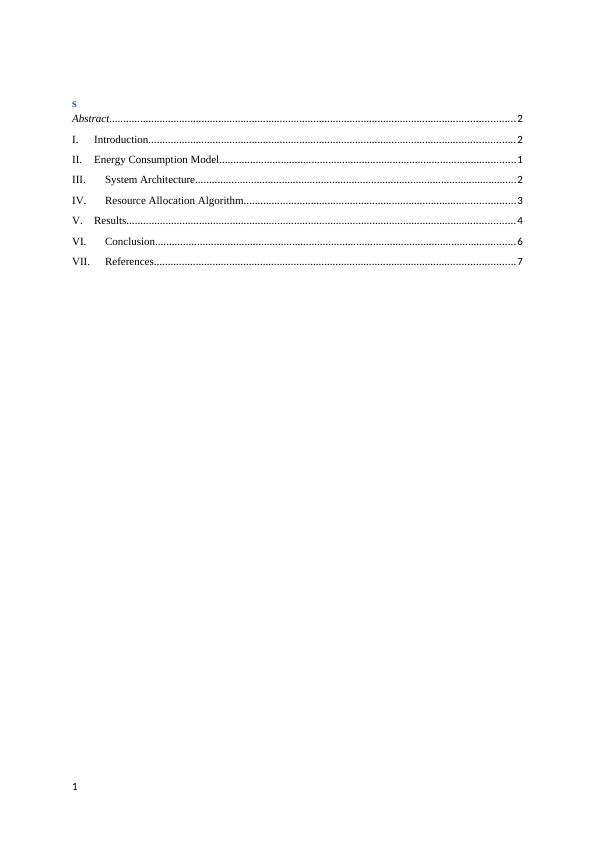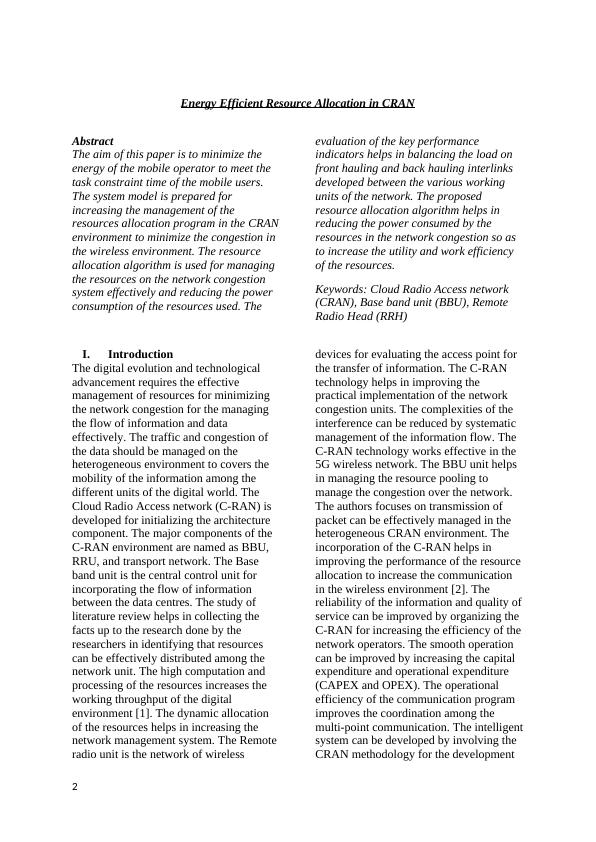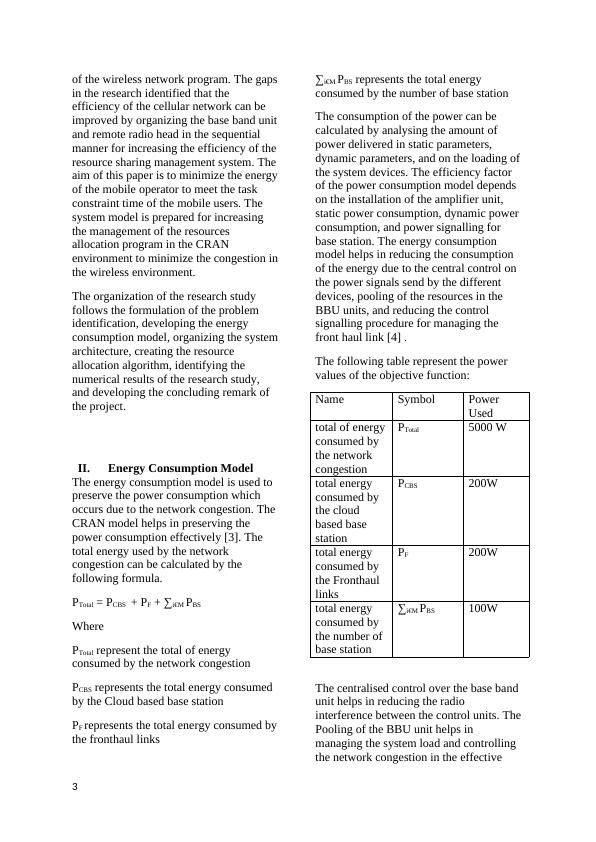Energy Efficient Resource Allocation in CRAN
Added on 2023-06-05
11 Pages4446 Words365 Views
Energy Efficient Resource Allocation in CRAN
Content
Content

s
Abstract.................................................................................................................................................2
I. Introduction...................................................................................................................................2
II. Energy Consumption Model..........................................................................................................1
III. System Architecture...................................................................................................................2
IV. Resource Allocation Algorithm.................................................................................................3
V. Results...........................................................................................................................................4
VI. Conclusion.................................................................................................................................6
VII. References.................................................................................................................................7
1
Abstract.................................................................................................................................................2
I. Introduction...................................................................................................................................2
II. Energy Consumption Model..........................................................................................................1
III. System Architecture...................................................................................................................2
IV. Resource Allocation Algorithm.................................................................................................3
V. Results...........................................................................................................................................4
VI. Conclusion.................................................................................................................................6
VII. References.................................................................................................................................7
1

Energy Efficient Resource Allocation in CRAN
Abstract
The aim of this paper is to minimize the
energy of the mobile operator to meet the
task constraint time of the mobile users.
The system model is prepared for
increasing the management of the
resources allocation program in the CRAN
environment to minimize the congestion in
the wireless environment. The resource
allocation algorithm is used for managing
the resources on the network congestion
system effectively and reducing the power
consumption of the resources used. The
evaluation of the key performance
indicators helps in balancing the load on
front hauling and back hauling interlinks
developed between the various working
units of the network. The proposed
resource allocation algorithm helps in
reducing the power consumed by the
resources in the network congestion so as
to increase the utility and work efficiency
of the resources.
Keywords: Cloud Radio Access network
(CRAN), Base band unit (BBU), Remote
Radio Head (RRH)
I. Introduction
The digital evolution and technological
advancement requires the effective
management of resources for minimizing
the network congestion for the managing
the flow of information and data
effectively. The traffic and congestion of
the data should be managed on the
heterogeneous environment to covers the
mobility of the information among the
different units of the digital world. The
Cloud Radio Access network (C-RAN) is
developed for initializing the architecture
component. The major components of the
C-RAN environment are named as BBU,
RRU, and transport network. The Base
band unit is the central control unit for
incorporating the flow of information
between the data centres. The study of
literature review helps in collecting the
facts up to the research done by the
researchers in identifying that resources
can be effectively distributed among the
network unit. The high computation and
processing of the resources increases the
working throughput of the digital
environment [1]. The dynamic allocation
of the resources helps in increasing the
network management system. The Remote
radio unit is the network of wireless
devices for evaluating the access point for
the transfer of information. The C-RAN
technology helps in improving the
practical implementation of the network
congestion units. The complexities of the
interference can be reduced by systematic
management of the information flow. The
C-RAN technology works effective in the
5G wireless network. The BBU unit helps
in managing the resource pooling to
manage the congestion over the network.
The authors focuses on transmission of
packet can be effectively managed in the
heterogeneous CRAN environment. The
incorporation of the C-RAN helps in
improving the performance of the resource
allocation to increase the communication
in the wireless environment [2]. The
reliability of the information and quality of
service can be improved by organizing the
C-RAN for increasing the efficiency of the
network operators. The smooth operation
can be improved by increasing the capital
expenditure and operational expenditure
(CAPEX and OPEX). The operational
efficiency of the communication program
improves the coordination among the
multi-point communication. The intelligent
system can be developed by involving the
CRAN methodology for the development
2
Abstract
The aim of this paper is to minimize the
energy of the mobile operator to meet the
task constraint time of the mobile users.
The system model is prepared for
increasing the management of the
resources allocation program in the CRAN
environment to minimize the congestion in
the wireless environment. The resource
allocation algorithm is used for managing
the resources on the network congestion
system effectively and reducing the power
consumption of the resources used. The
evaluation of the key performance
indicators helps in balancing the load on
front hauling and back hauling interlinks
developed between the various working
units of the network. The proposed
resource allocation algorithm helps in
reducing the power consumed by the
resources in the network congestion so as
to increase the utility and work efficiency
of the resources.
Keywords: Cloud Radio Access network
(CRAN), Base band unit (BBU), Remote
Radio Head (RRH)
I. Introduction
The digital evolution and technological
advancement requires the effective
management of resources for minimizing
the network congestion for the managing
the flow of information and data
effectively. The traffic and congestion of
the data should be managed on the
heterogeneous environment to covers the
mobility of the information among the
different units of the digital world. The
Cloud Radio Access network (C-RAN) is
developed for initializing the architecture
component. The major components of the
C-RAN environment are named as BBU,
RRU, and transport network. The Base
band unit is the central control unit for
incorporating the flow of information
between the data centres. The study of
literature review helps in collecting the
facts up to the research done by the
researchers in identifying that resources
can be effectively distributed among the
network unit. The high computation and
processing of the resources increases the
working throughput of the digital
environment [1]. The dynamic allocation
of the resources helps in increasing the
network management system. The Remote
radio unit is the network of wireless
devices for evaluating the access point for
the transfer of information. The C-RAN
technology helps in improving the
practical implementation of the network
congestion units. The complexities of the
interference can be reduced by systematic
management of the information flow. The
C-RAN technology works effective in the
5G wireless network. The BBU unit helps
in managing the resource pooling to
manage the congestion over the network.
The authors focuses on transmission of
packet can be effectively managed in the
heterogeneous CRAN environment. The
incorporation of the C-RAN helps in
improving the performance of the resource
allocation to increase the communication
in the wireless environment [2]. The
reliability of the information and quality of
service can be improved by organizing the
C-RAN for increasing the efficiency of the
network operators. The smooth operation
can be improved by increasing the capital
expenditure and operational expenditure
(CAPEX and OPEX). The operational
efficiency of the communication program
improves the coordination among the
multi-point communication. The intelligent
system can be developed by involving the
CRAN methodology for the development
2

of the wireless network program. The gaps
in the research identified that the
efficiency of the cellular network can be
improved by organizing the base band unit
and remote radio head in the sequential
manner for increasing the efficiency of the
resource sharing management system. The
aim of this paper is to minimize the energy
of the mobile operator to meet the task
constraint time of the mobile users. The
system model is prepared for increasing
the management of the resources
allocation program in the CRAN
environment to minimize the congestion in
the wireless environment.
The organization of the research study
follows the formulation of the problem
identification, developing the energy
consumption model, organizing the system
architecture, creating the resource
allocation algorithm, identifying the
numerical results of the research study,
and developing the concluding remark of
the project.
II. Energy Consumption Model
The energy consumption model is used to
preserve the power consumption which
occurs due to the network congestion. The
CRAN model helps in preserving the
power consumption effectively [3]. The
total energy used by the network
congestion can be calculated by the
following formula.
PTotal = PCBS + PF + ∑i€M PBS
Where
PTotal represent the total of energy
consumed by the network congestion
PCBS represents the total energy consumed
by the Cloud based base station
PF represents the total energy consumed by
the fronthaul links
∑i€M PBS represents the total energy
consumed by the number of base station
The consumption of the power can be
calculated by analysing the amount of
power delivered in static parameters,
dynamic parameters, and on the loading of
the system devices. The efficiency factor
of the power consumption model depends
on the installation of the amplifier unit,
static power consumption, dynamic power
consumption, and power signalling for
base station. The energy consumption
model helps in reducing the consumption
of the energy due to the central control on
the power signals send by the different
devices, pooling of the resources in the
BBU units, and reducing the control
signalling procedure for managing the
front haul link [4] .
The following table represent the power
values of the objective function:
Name Symbol Power
Used
total of energy
consumed by
the network
congestion
PTotal 5000 W
total energy
consumed by
the cloud
based base
station
PCBS 200W
total energy
consumed by
the Fronthaul
links
PF 200W
total energy
consumed by
the number of
base station
∑i€M PBS 100W
The centralised control over the base band
unit helps in reducing the radio
interference between the control units. The
Pooling of the BBU unit helps in
managing the system load and controlling
the network congestion in the effective
3
in the research identified that the
efficiency of the cellular network can be
improved by organizing the base band unit
and remote radio head in the sequential
manner for increasing the efficiency of the
resource sharing management system. The
aim of this paper is to minimize the energy
of the mobile operator to meet the task
constraint time of the mobile users. The
system model is prepared for increasing
the management of the resources
allocation program in the CRAN
environment to minimize the congestion in
the wireless environment.
The organization of the research study
follows the formulation of the problem
identification, developing the energy
consumption model, organizing the system
architecture, creating the resource
allocation algorithm, identifying the
numerical results of the research study,
and developing the concluding remark of
the project.
II. Energy Consumption Model
The energy consumption model is used to
preserve the power consumption which
occurs due to the network congestion. The
CRAN model helps in preserving the
power consumption effectively [3]. The
total energy used by the network
congestion can be calculated by the
following formula.
PTotal = PCBS + PF + ∑i€M PBS
Where
PTotal represent the total of energy
consumed by the network congestion
PCBS represents the total energy consumed
by the Cloud based base station
PF represents the total energy consumed by
the fronthaul links
∑i€M PBS represents the total energy
consumed by the number of base station
The consumption of the power can be
calculated by analysing the amount of
power delivered in static parameters,
dynamic parameters, and on the loading of
the system devices. The efficiency factor
of the power consumption model depends
on the installation of the amplifier unit,
static power consumption, dynamic power
consumption, and power signalling for
base station. The energy consumption
model helps in reducing the consumption
of the energy due to the central control on
the power signals send by the different
devices, pooling of the resources in the
BBU units, and reducing the control
signalling procedure for managing the
front haul link [4] .
The following table represent the power
values of the objective function:
Name Symbol Power
Used
total of energy
consumed by
the network
congestion
PTotal 5000 W
total energy
consumed by
the cloud
based base
station
PCBS 200W
total energy
consumed by
the Fronthaul
links
PF 200W
total energy
consumed by
the number of
base station
∑i€M PBS 100W
The centralised control over the base band
unit helps in reducing the radio
interference between the control units. The
Pooling of the BBU unit helps in
managing the system load and controlling
the network congestion in the effective
3

End of preview
Want to access all the pages? Upload your documents or become a member.
Related Documents
Spectrum Sensing Techniques and Cognitive Radiolg...
|27
|5112
|123
(PDF) A Critical Overview of Internet of Things in Educationlg...
|4
|529
|150
Lightweight Encryption Algorithm for Secure Communication in IoTlg...
|1
|1217
|307
Critical Review of Green Networks and People: A Review of Research and Practice in the Analysis and Planning of Multi-functional Green Networkslg...
|8
|3888
|87
Lightweight Encryption Algorithm for Secure IOTlg...
|53
|14901
|228
Key Technologies for 5G Wireless Systemslg...
|21
|5245
|226
